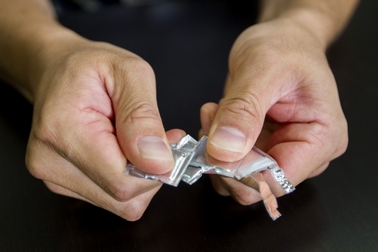Origami, the centuries-old Japanese paper-folding art, has inspired recent designs for flexible energy-storage technology. But energy-storage device architecture based on origami patterns has so far been able to yield batteries that can change only from simple folded to unfolded positions. They can flex, but not actually stretch.

Now an Arizona State University research team has overcome the limitation by using a variation of origami, called kirigami, as a design template for batteries that can be stretched to more than 150 percent of their original size and still maintain full functionality.
Hanqing Jiang, an associate professor in the School for Engineering of Matter, Transport and Energy, one of ASU’s Ira A. Fulton Schools of Engineering, leads the team.
The kirigami-based prototype battery was sewn into an elastic wristband that was attached to a smart watch. The battery fully powered the watch and its functions, including playing video, as the band was being stretched.
“This type of battery could potentially be used to replace the bulky and rigid batteries that are limiting the development of compact wearable electronic devices,” Jiang said.
Such stretchable batteries could even be integrated into fabrics, including those used for clothing, he said.
Leading members of his ASU research team are: Hongyu Yu, an associate professor in the School of Electrical, Computer and Energy Engineering and the School of Earth and Space Exploration; Zeming Song, a materials science doctoral student; and Xu Wang, a mechanical engineering doctoral student.
Jiang credits Song and Wang for ideas for using various kirigami patterns, as well as for conducting experiments and characterizing the properties of the materials used to develop the technology.
Other contributors include ASU engineering graduate students Cheng Lv, Yonghao An, Mengbing Liang, Teng Ma and David He, a Phoenix high school student, along with Ying-Jie Zheng and Shi-Qing Huang from the MOE Key Lab of Disaster Forecast and Control in Engineering at Jinan University, Guangzhou, China.







